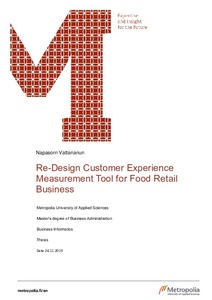Re-Design Customer Experience Measurement Tool for Food Retail Services
Vattananun, Napasorn (2019)
Vattananun, Napasorn
2019
All rights reserved. This publication is copyrighted. You may download, display and print it for Your own personal use. Commercial use is prohibited.
Julkaisun pysyvä osoite on
https://urn.fi/URN:NBN:fi:amk-202001101199
https://urn.fi/URN:NBN:fi:amk-202001101199
Tiivistelmä
The objective of this thesis was to re-design the customer experience measurement tool for retail food business at aFinnish food service & catering company. The company was struggling withtheircustomer experience, resulting in aloss of sales and profits, as well as competitiveness in the previous years. The study was commissioned to investigate why the company failed to enhance customer experience and to suggest an approachto re-design the customer experience measurement tool as part of the customer journey.
This thesis was carried out as an action research. Both qualitative and quantitative methods were used. Within the scope of the current state analysis, qualitative research data was gathered through eighty contextual interviews with potential customers and two contextual interviews with service managers, to gain more in-depth information.
The outcomes of the interviews confirmed that the company was struggling to improve customer experience systematically and measurable. The majority of the respondents were not familiar with the current customer experience measurement tool. In addition, over seventy percent of the respondents missed the incentive to give feedback. The respondents felt that their feedback wasnotpassed on. The customer journey did not collect data nor create a definite attempt to personalize.
The author suggests the company to integrate the re-design of the customer experience measurement tool as part of their service. It would help the company to better measure and execute customer experiences through the specification of the detractors throughout the customer journey, the prediction of future customer behaviors, and the reflection of customer loyalty. The author recommends that the case company should always communicate with customers, update key performance indicators, and matter customer’s opinions.
This thesis was carried out as an action research. Both qualitative and quantitative methods were used. Within the scope of the current state analysis, qualitative research data was gathered through eighty contextual interviews with potential customers and two contextual interviews with service managers, to gain more in-depth information.
The outcomes of the interviews confirmed that the company was struggling to improve customer experience systematically and measurable. The majority of the respondents were not familiar with the current customer experience measurement tool. In addition, over seventy percent of the respondents missed the incentive to give feedback. The respondents felt that their feedback wasnotpassed on. The customer journey did not collect data nor create a definite attempt to personalize.
The author suggests the company to integrate the re-design of the customer experience measurement tool as part of their service. It would help the company to better measure and execute customer experiences through the specification of the detractors throughout the customer journey, the prediction of future customer behaviors, and the reflection of customer loyalty. The author recommends that the case company should always communicate with customers, update key performance indicators, and matter customer’s opinions.
